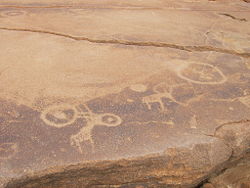Twyfelfontein | |
|---|---|
 A sandstone slab at Twyfelfontein. The animals are the older engravings, overlaid by the circles. | |
| Coordinates: 20°35′26″S 14°22′20″E / 20.59056°S 14.37222°E | |
| Country | |
| Region | Kunene Region |
| Constituency | Khorixas Constituency |
| Area | |
| • Land | 0.222 sq mi (0.574 km2) |
| • Water | 0 sq mi (0 km2) |
| Elevation | 1,800 ft (550 m) |
| Time zone | UTC+1 (South African Standard Time) |
| [1][2] | |
| Official name | Twyfelfontein or /Ui-//aes |
| Criteria | Cultural: (iii), (v) |
| Reference | 1255 |
| Inscription | 2007 (31st Session) |
| Area | 57.4 ha (142 acres) |
| Buffer zone | 9,194.5 ha (22,720 acres) |
Twyfelfontein (Afrikaans: uncertain spring), officially known as ǀUi-ǁAis (Damara/Nama: jumping waterhole), is a site of ancient rock engravings in the Kunene Region of north-western Namibia. It consists of a spring in a valley flanked by the slopes of a sandstone table mountain that receives very little rainfall and has a wide range of diurnal temperatures.
The site has been inhabited for 6,000 years, first by hunter-gatherers and later by Khoikhoi herders. Both ethnic groups used it as a place of worship and a site to conduct shamanist rituals. In the process of these rituals at least 2,500 items of rock carvings have been created, as well as a few rock paintings. Displaying one of the largest concentrations of rock petroglyphs in Africa, UNESCO approved Twyfelfontein as Namibia's first World Heritage Site in 2007.
